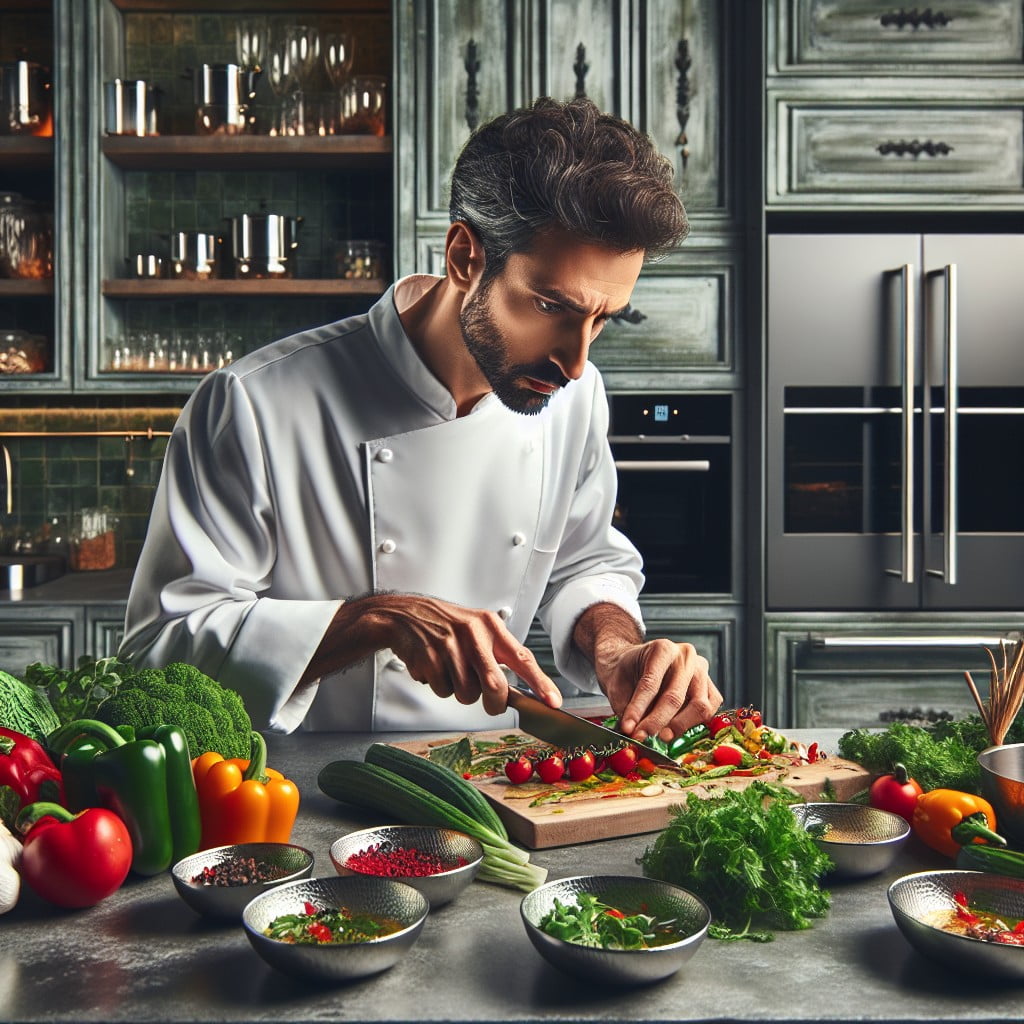Last updated on
Unleash the culinary magic woven into every recipe at Appeasing a Food Geek, because this blog offers an in-depth look into the remarkable science behind your favourite dishes and the sophisticated techniques that bring them to life.
Embarking on a culinary journey, the “Appeasing a Food Geek” blog unlocks the essence of creating extraordinary dishes, while delving deep into the world of food aficionados.

From unearthing the importance of high-caliber ingredients to mastering indispensable tools of the trade, this platform is a treasure trove for those hungry to enhance their gastronomic prowess.
With insightful reviews and a thorough exploration of global cuisines, readers gain a holistic understanding that transcends the staple act of cooking, fostering a community where knowledge is served as the main course.
Aspiring to transform kitchen experiments into remarkable dining experiences, the blog also navigates the digital sphere, offering pearls of wisdom on captivating a like-minded audience through the art of social media engagement.
The following insights unwrap the magic behind fantastic recipes and the cultural tapestry they weave, serving as a guide for both novice cooks and seasoned chefs alike.
Key takeaways:
- Engaging with food culture preserves and evolves regional cuisines.
- Appeasing a Food Geek blog celebrates culinary craftsmanship and education.
- Sourcing high-quality ingredients is essential for exceptional dishes.
- Essential kitchen equipment includes knives, skillets, scales, and spatulas.
- Reviews of popular dishes evaluate quality, originality, balance, and pairings.
- Exploring new cuisines involves research, staples, seasonality, and flavors.
- Sharing knowledge with fellow food geeks builds community and creativity.
- Understanding the science of food elevates cooking from good to extraordinary.
- Growing an audience through social media requires consistency and engagement.
Understanding Food Culture and the Role of Food Geeks
Food culture encompasses the practices, attitudes, and traditions surrounding the production, distribution, preparation, and consumption of food. It’s the collective heartbeat of culinary identity within a community, reflecting history, geography, and the interplay with local ingredients.
Food geeks thrive within this realm. These passionate individuals immerse themselves in the nuances of food, elevating their understanding beyond mere sustenance to an art form. They often lead the charge in preserving traditional methods while also pioneering innovative techniques and flavors.
Embracing food culture allows food geeks to:
- Engage with the storied history of regional cuisines and contribute to their preservation and evolution.
- Celebrate seasonal and local produce, supporting sustainability and local economies.
- Foster a sense of community by sharing meals and food experiences that bridge cultural divides.
- Experiment with food combinations and cooking methods to unlock new taste sensations.
- Inspire others to step out of their culinary comfort zones and explore a wider world of ingredients and dishes.
By delving deeply into the why and how of cooking, these culinary enthusiasts enhance their appreciation of the meals they create and connect more deeply with the cultures that inspire them.
The Concept Behind Appeasing a Food Geek Blog
At the heart of the blog lies a profound respect for the craft of cooking. It’s where passion for the science of flavors meets the art of presentation.
Here are some key points that define the blog’s essence:
- Celebration of Culinary Craftsmanship: Detailed explorations of cooking techniques, presentations, and flavor profiles are commonplace, emphasizing the mastery involved in creating exceptional dishes.
- Ingredient Spotlight: Special attention is paid to the selection and treatment of ingredients, highlighting the importance of freshness, sourcing, and the impact they have on the final product.
- Educational Perspective: The blog serves as a platform to dive into the ‘why’ behind cooking processes, offering an insight into the food science that guides kitchen successes.
- Innovation and Inspiration: Readers are encouraged to push the boundaries of traditional recipes, experimenting with new combinations and concepts to ignite culinary creativity.
- Community Engagement: The space thrives on the exchange of ideas, inviting interaction with fellow food enthusiasts to cultivate a shared learning experience.
Ingredients: Finding the Best Quality and Variation
Sourcing high-quality ingredients is akin to an artist selecting their paints—it elevates the dish to a masterpiece. Here are some points to guide food enthusiasts in their quest for the finest produce:
- Local farmers’ markets are treasure troves of fresh, organic produce. Engage with the farmers to learn about the origin and best use of their offerings.
Seasonality matters. Choosing fruits and vegetables in their natural growing season ensures peak flavor and nutrition.
Specialty stores offer an array of unique and ethnic ingredients that can be difficult to find elsewhere. These shops often provide authentic flavors needed for traditional recipes.
Sustainability is key. Opt for ingredients that are responsibly sourced and environmentally friendly to support ethical eating habits.
Label Reading: Pay close attention to labels when shopping for packaged items. Look for minimal ingredients and names you recognize – the fewer additives, the better.
Variation is not just the spice of life but of the kitchen too. Experimenting with different herbs, spices, and condiments can transform a familiar dish into something exciting and new.
Taste Testing: When possible, taste before you buy, especially with items like cheese, olives, or artisan bread. Your palate will guide you to the best choice.
Remember, the quality of your ingredients directly influences the taste and success of your culinary creations, so choose wisely.
Essential Kitchen Equipment for Food Geeks
Having the right tools can transform your cooking from good to great. High-quality knives top the list, significantly affecting prep work. A chef’s knife, for precision cutting, and a paring knife, for detail work, are indispensable. A reliable cutting board, preferably wood or bamboo, protects knives and countertops alike.
Invest in a durable, heavy-bottomed skillet that can evenly distribute heat, essential for perfect searing or sautéing. A cast-iron skillet is versatile, ideal for stovetop to oven cooking.
Digital scales ensure ingredient accuracy, a fundamental for baking success, while a set of measuring spoons and cups cater to both liquid and dry components.
An instant-read thermometer removes guesswork from cooking meat, while silicone spatulas withstand high temperatures and help with efficient stirring and folding.
For food geeks aspiring to elevate their culinary experience, a sous-vide machine offers precision in temperature control, resulting in consistently cooked dishes.
Lastly, stock your kitchen with a variety of baking sheets and cookware suitable for different methods, such as roasting or broiling, to broaden your repertoire and execution of recipes. Quality equipment can inspire confidence and elevate your cooking adventures.
Reviews of Popular Dishes From Top Restaurants
When dining out, the experience is as crucial as the flavors savored. Take your taste buds on a guided tour by diving into the intricacies of popular restaurant dishes. Evaluate the interplay of textures and tastes, presenting a clear picture of what makes a dish stand out—or fall flat. Critiques should shine a light on the chef’s creativity, the harmony of the seasoning, and the presentation’s impact.
Consider these key factors:
- Ingredient quality: Fresh and locally sourced products often elevate a dish, reflecting the chef’s commitment to excellence.
- Originality: Highlight how the dish distinguishes itself from classic renditions – what twist has the chef employed?
- Balance: Assess how the different components come together for a cohesive flavor profile. Is there a good ratio of acidity, sweetness, and umami?
- Pairings: Discuss suggested drink pairings or side choices that complement the main course.
- Atmosphere: Sometimes the restaurant’s ambiance can enhance the dining experience, adding value to the dish itself.
By focusing on the merits and potential improvements, your review guides fellow food enthusiasts towards memorable culinary adventures while respecting the artistry involved in high-level cuisine.
Exploring New Cuisines and Flavours
Embarking on a culinary journey helps to expand your palate and deepen your understanding of global cultures. To fully appreciate the essence of new cuisines, consider these pointers:
1. Research Traditions: Understand the historical and cultural significance of the dishes. This enriches the dining experience and provides context for the flavors you’ll encounter.
2. Start with Staples: Identify staple ingredients and dishes of a cuisine to get a foundational sense of its flavor profile. This could range from spices in Indian cooking to staple meats used in Korean dishes.
3. Seasonal and Local: Foods consumed by locals and ones that are in season will deliver the freshest taste and offer a genuine experience of the cuisine.
4. Cooking Methods: Be open to different cooking practices; steaming, fermenting, or grilling can dramatically alter the flavor of ingredients.
5. Balance Flavors: Learn about the cuisine’s approach to balancing sweet, salty, sour, and bitter flavors, and how it achieves its unique taste.
6. Spice Tolerance: Gradually acclimate your palate to different levels of spiciness – a common characteristic in many regional foods that can be tailored to your comfort.
7. Language of Food: Some cuisines communicate through their dishes, offering insights into regional idiosyncrasies and ethos. For instance, the communal eating of Ethiopian food conveys a sense of togetherness.
8. Interactive Dining: Engage in the full sensory experience, whether it’s using chopsticks, eating with your hands, or preparing the food tableside.
By keeping these points in mind, you will gain not just a meal, but a story; each dish tells a tale of its origin and the people who created it.
Sharing Knowledge and Collaborating With Other Food Geeks
Building a community with fellow enthusiasts amplifies the joy of cooking and gourmandizing. Swap recipes, techniques, and anecdotes through forums, social media groups, or during themed potluck gatherings.
Collaboration can take the form of guest blogging, where sharing your culinary experiments on someone else’s platform offers fresh perspectives to a wider audience. Join local cooking classes or workshops not just to enhance your skills but also to network with like-minded individuals.
Participate in online challenges or create your own to engage with the community. These connections often lead to recipe swaps, discovering new food blogs, and sometimes spark innovations in the kitchen that could revolutionize your cooking game.
The Science of Food
Delving into the intricacies of what makes flavors and textures in our favorite recipes so delightful often leads us to the doorstep of food science. Understanding the chemistry of cooking can elevate a dish from good to extraordinary.
Food science demystifies the changes ingredients undergo between the pantry and the plate:
- Maillard Reaction: This is the chemical reaction between amino acids and reducing sugars that gives browned food, like seared steak or toasted marshmallows, its distinctive flavor.
- Emulsification: It’s what happens when oil and vinegar combine to create a stable salad dressing thanks to an emulsifier, like mustard, that keeps them from separating.
- Gelatinization: When heat is applied to starch and liquid, thickening occurs—think of the magic when flour meets broth to form a gravy’s body.
- Caramelization: The process through which natural sugars in food become brown and flavorful upon heating, lending a sweet complexity to everything from onions to desserts.
- Fermentation: This biochemical marvel converts carbohydrates to alcohol or organic acids using microorganisms—yeast or bacteria. It’s the force behind the tang of sourdough and the effervescence of kimchi.
A solid grasp of these concepts not only aids in troubleshooting and recipe development but also in appreciating the transformative nature of cooking. With this scientific foundation, food geeks can push culinary boundaries and create mesmerizing meals that tickle taste buds and forge memorable dining experiences.
Growing and Engaging Your Audience Through Social Media
With the abundance of social platforms, establishing a strong presence where your readers spend the most time is vital. Create a cohesive brand image across Facebook, Instagram, Twitter, or Pinterest, uploading quality photos and engaging content related to food discoveries, recipe innovations, and culinary experiments.
Utilize Instagram stories and live sessions to share real-time cooking demonstrations or market visits. This not only adds a layer of authenticity but can also increase real-time engagement. Engage audiences by asking for their opinions, hosting Q&A sessions, and encouraging them to share their own culinary adventures using a specific hashtag related to your blog.
Leverage Twitter for sharing quick tips, linking to your latest blog posts, or joining food-related conversations. Twitter chats are an excellent way to connect with food enthusiasts and influencers.
Pinterest, with its visual appeal, can be a powerful tool to drive traffic. Create pinboards for various food categories, ensuring your pins link back to your blog for readers to access the full recipes.
Remember, consistency is key. Regular posts keep your follower base engaged and help attract new followers through increased visibility and shareability of your content. Engage with your audience regularly by responding to comments, visiting their profiles, and showing appreciation for their input. This fosters a sense of community and can lead to a loyal following.
Recap:




